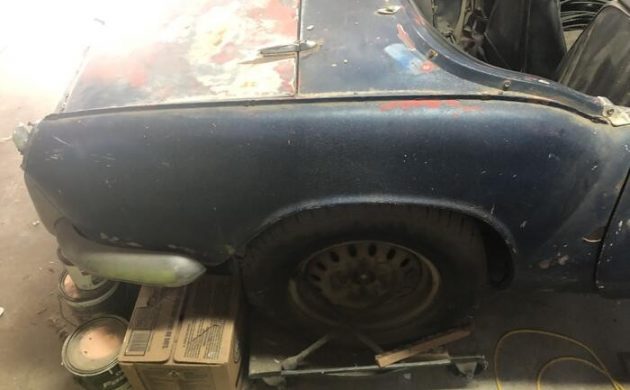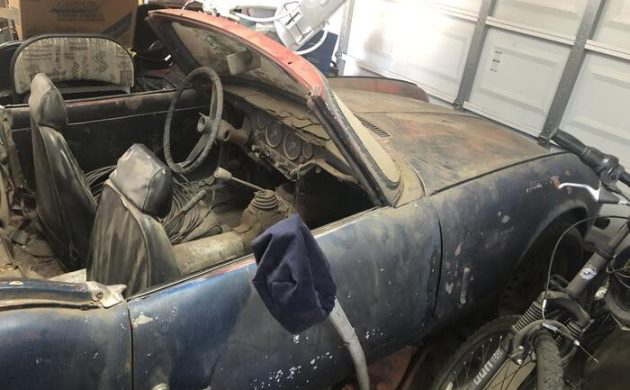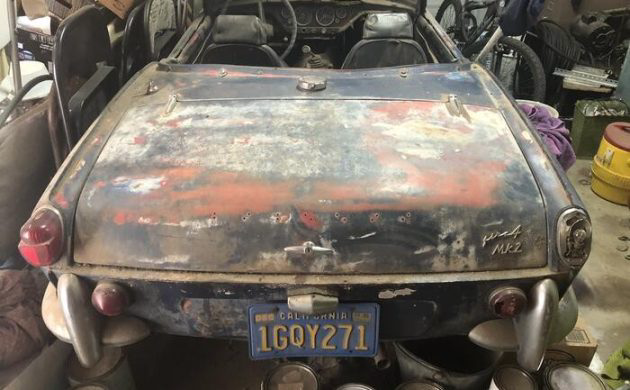Sometimes a car that has been well-loved passes the point where its current owner can put it back on the road. When this happens, many will enter a state of denial, holding fast to their dream until it rusts to nothing. Fortunately, that’s not the case for this classic roadster, located in Fresno, California. The long-time owner of this Triumph Spitfire Mk2 has put it up for sale here on Triumph Experience for $1,000.
Triumph introduced the Spitfire in 1963 to compete with the MG Midget and Austin Sprite. This it did with great success, due to its sharp Italian looks (courtesy of Giovanni Michelotti) and to having far more features that the BMC offerings– including such luxuries as roll-up windows. The Mk2 was powered by the same 1147cc I4 that had made its appearance in the Herald 1200 in 1961, but the engine’s power output was increased to 67 bhp. This was delivered to the rear wheels through a four-speed manual gearbox, ultimately providing in a top speed of 96 mph. An optional overdrive was introduced in 1964, but it’s not clear if this particular example is so equipped.
The owner of this Spitfire states that he bought the car in Hot Springs, Arkansas, when he was in the Air Force. The car accompanied him back to California, but was damaged in 1983. Necessary repairs stacked up, and the car hasn’t moved from his garage since. Looking at the pictures, it seems to need a bit of everything, but it does have several things going for it. First, it’s a very desirable early model, built before the bone-in-teeth bumper, much less the rubber monstrosities and clipped rear of the Seventies. It’s worth noting that it’s probably not, as the ad states, a 1964: production on the Mk2 didn’t begin until December of that year and the new model wasn’t launched until March of 1965. Year model aside, the history of the car indicates that it’s been in warm weather for most of its life, which should mitigate the rust situation somewhat. Even if we can’t see the bottom of the panels or under the car in the photos, the rest looks pretty solid. Finally, the rear end has been swapped out for that of a ’72 model. This should provide a real suspension upgrade when compared to the Mk2– a pivoting leaf spring was introduced in 1970 to help ameliorate the well-known oversteer problem in earlier models.
In short, if you’re looking for a classic British project in the Fresno area, you could probably do worse. Spitfires were made for nearly twenty years, so spare parts– and even whole donor vehicles– are plentiful and inexpensive. In addition, new parts are available from a variety of suppliers. The model shares a knowledge base and club support probably only equaled by that for the MGB. And, finally, since it was designed as a no-frills, low-cost sports car, it’s mechanically simple. Once restored, this could be a gorgeous roadster offering an engaging driving experience with a relatively low cost of ownership. Sometimes, when you love something, you have to let it go and hope that someone else can pick up the baton. In the end, it’s a question of whether someone thinks this little car is still worthy of some love.





Cool old Triumph! I don’t really see how you could go wrong here if you lived within driving distance and had the use of a trailer.
These early cars are getting hard to find. I can remember several that rusted to the point of being parts cars we used to restore several other cars. Got a friend we race with has 3 versions of the early Spitfires and he is holding on to them like they were gold plated. If this one has a solid frame it’s surly a good candidate for restoration.
Basically this version is an MG Midget with slightly different sheet metal. Lots of mechanical parts are shared. That means parts should be easy to find. This car could be restored with a lot of work and no that much money
I’m not trying to be a smartass, but they have nothing in common with a early midget. Midgets had a 1275 bmc engine and the spits had either a 1100 or 1300 engine and nothing was the same. You might be thinking about the much later 1975 and later midgets and spitfires which did share the same engine and transmission.
You are right about parts being easy to get and not a bunch of money.
I think he got this car confused with the AH Sprite – all good!
Absolutely love the early Spitfires and GT6s! Well with the effort to restore if the frame is good.
Had a 67 Mk 2, that’s where I learned my lesson on British cars. When it was running it was fun but when it wasn’t – Wow. 3 especially bad things about it: one was if you parked it other than on the level the fluid leaked out of the clutch cylinder (finally fixed with replacing parts). Second was the time I got into it and half way into the street and the steering wheel disconnected from the steering box (was able to bolt it back up). The 3d was one time when out driving the small plastic line came unhooked from the carb dumping gas on the exhaust header (didn’t have any tools but did have a piece of board I could wedge under the carb to keep the gas off the header). Drove home about 10 miles with the top off in case I had to bail on it.
That was enough for me, got rid of it and never looked back.
Facts… First Midget, 1962, was unit construction body like the Bugeye with the same 948 engine. In ’64 they put a 1075 engine into them and in ’67 put in the 1275. Late ’74 the Spitfire engine and transmission was installed to meet the US smog laws. That’s also when the big rubber bumpers appeared.
Correction: the ’64 engine was a 1098.
While there is a “Mk2” badge on the decklid, the front grille and, more importantly, the Commission number make this a 1964 Spitfire 4, NOT a Mk2. It looks to be a fun project for the right person (not me, as I’m on the wrong side of the country).
I just saw one in a junkyard last week. It reminded me of my first car which was a red 65 Spit. The one I saw was green. The floors were gone, I did see an engine and it did have the doors, trunk lid and front bonnet but the tin worm had been hard at work on that poor old car. I think I could have gotten a wheelbarrows worth of parts for not much money. I actually entertained the idea of buying the engine and having fun rebuilding it. Still have my old spit manuals to refer to. But then I remembered I don’t have time to get done what I need to do much less add another thing to the list. So hopefully the right guy will find the car and get something useful from it.
Terry….you’re way off track. With the exception of some Lucas parts or SU carburetors that were common across multiple British cars at the time, there is pretty much NOTHING that the Mk2 Spitfire has in common with contemporary MG Midget. I think you might be getting confused with the AH Sprite and MG Midget which were for several years (beyond the bug eye models) pretty much he same car with different badges.
MG and Triumph did eventually end up as fellow subsidiaries in the great British Leyland chaos but not when this car was made.
Ahhh, my first British experience (if you don’t count the family’s Vauxhall when I was 6) was a Spitfire GIVEN to me by the original owner. They had accumulated only 20k miles then parked it along the path to a goat pasture on their farm. When I heard the car still existed in 2010, I extracted it for parts. Swiss cheese doesn’t begin to describe what condition the steel was in after sitting in all types of weather for 30 years! The underside of the bonnet was in perfect condition with chalk marks from the factory and owner’s instructional decals intact. The radio surprisingly worked when given the juice.
At the end of the day, you can restore almost anything if you have enough money but in this case, the owner should be ashamed of himself.